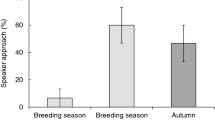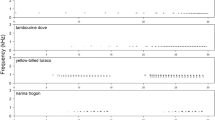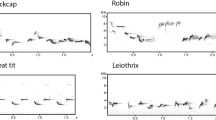Abstract
To date, song research has focused primarily on the interactions of conspecifics. However, frequent interactions of songbirds with heterospecifics may necessitate adequate communication outside the species boundary. In this study, we focus on heterospecific communication behaviour of two small sympatric congeneric passerines, great and blue tits (Parus major and Parus caeruleus), which breed in overlapping territories and compete for food and nesting cavities. By means of a first playback experiment, we show that (1) heterospecific matching (imitating songs of the other species) is a strategy frequently used by great tits but not by blue tits, (2) both blue tit trilled and untrilled song can be accurately matched by great tits and that (3) almost half of the great tits in our study population match at least one blue tit song across all studied breeding stages, indicating that this heterospecific matching behaviour is a common feature in this population. A second playback experiment showed that these great tit imitations of blue tit songs do not function in intraspecific communication between male great tits. Hence, these heterospecific imitations appear to be designed for interspecific communication with blue tits. These findings suggest a strong heterospecific influence on the vocal learning process, repertoire composition and repertoire use in great tits and provide a possible mechanism that can drive song convergence in songbirds.



Similar content being viewed by others
References
Baptista LF, Catchpole CK (1989) Vocal mimicry and interspecific aggression in songbirds: experiments using white-crowned sparrow imitation of song sparrow song. Behaviour 109:247–257
Baylis JR (1982) Avian vocal mimicry: its function and evolution. In: Kroodsma DE, Miller EH (eds) Acoustic communication in birds. Production, perception and design features of sounds. Academic, New York pp 51–83
Becker PH (1982) The coding of species-specific characteristics in bird sounds. In: Kroodsma DE, Miller EH (eds) Acoustic communication in birds. Production, perception and design features of sounds. Academic, New York pp 213–252
Beecher MD, Campbell SE, Burt JM, Hill CE, Nordby JC (2000) Song-type matching between neighbouring song sparrows. Anim Behav 59:21–27
Blakey JK (1994) Genetic evidence for extra-pair fertilizations in a monogamous passerine, the great Parus major. Ibis 136:457–462
Brémond JC (1968) Recherches sur la sémantique et les elements vecteurs d’information dans les signaux acoustique du rouge-gorge (Erithacus rubecula L.). Terre Vie 2:109–220
Catchpole CK (1978) Interspecific territorialism and competition Acrocephalus warblers as revealed by playback experiments in area of sympatry and allopatry. Anim Behav 26:1072–1082
Catchpole CK, Baptista LF (1988) A test of the competition hypothesis of vocal mimicry, using song sparrow imitation of white-crowned sparrow song. Behaviour 106:119–128
Catchpole CK, Slater PJB (1995) Bird song: biological themes and variations. Cambridge Univ Press, Cambridge
Cody ML (1973) Character convergence. Annu Rev Syst Ecol 4:189–211
Cramp S, Perrins CM (1993) The birds of the Western Paleartic, vol. VII. Oxford Univ Press, Oxford
Dabelsteen T, McGregor PK, Shepherd M, Whittaker X, Pedersen SB (1996) Is the signal value of overlapping different from that of alternating during matched singing in Great Tits? J Avian Biol 27:189–194
Dabelsteen T, McGregor PK, Holland J, Tobias JA, Pedersen SB (1997) The signal function of overlapping singing in male robins. Anim Behav 53:249–256
Dobkin DS (1979) Functional and evolutionary relationships of vocal copying phenomena in birds. Z Tierpsychol 50: 348–363
Dhondt AA (1977) Interspecific competition between great and blue tit. Nature 268:521–523
Dhondt AA, Eyckerman R (1980) Competition and the regulation of numbers in great and blue tit. Ardea 68:121–132
Doutrelant C, Lambrechts MM (2001) Macrogeographic variation in song—a test of competition and habitat effects in blue tits. Ethology 107:533–544
Doutrelant C, Aubin T, Hitier S, Lambrechts MM (1998) Two distinct song populations of blue tits, Parus caeruleus, in the French Mediterranean. Bioacoustics 9:1–16
Doutrelant C, Leitao A, Otter K, Lambrechts MM (2000) Effect of blue tit song syntax on great tit territorial responsiveness—an experimental test of the character shift hypothesis. Behav Ecol Sociobiol 48:119–124
Falls JB, Krebs JR, McGregor PK (1982) Song matching in the great tit (Parus major): the effect of similarity and familiarity. Anim Behav 30:997–1009
Ferguson JWH, van Zyl A, Delport K (2002) Vocal mimicry in African ossypha robin chats. J Ornithol 139:319–330
Geberzahn N, Hultsch H (2003) Long-time storage of song types in birds: evidence from interactive playbacks. Proc R Soc Lond B 270:1085–1090
Geberzahn N, Hultsch H, Todt D (2002) Latent song type memories are accessible through auditory stimulation in a hand-reared songbird. Anim Behav 64:783–790
Gorissen M (2002) Onderzoek naar de akoestische interacties tussen pimpelmezen en koolmezen. Master’s Thesis, University of Antwerp, Antwerp
Gorissen L (2005) The vocal communication strategies of blue and great tits, studied from an intra- and interspecific perspective. Doctoral Dissertation, University of Antwerp, Antwerp
Gorissen L, Eens M (2004) Interactive communication between male and female great tits (Parus major) during the dawn chorus. Auk 121:184–191
Haavie J, Borge T, Bures S, Garamszegi LZ, Lampe HM, Moreno J, Qvarnström A, Török J, Saetre G-P (2004) Flycatcher song in allopatry and sympatry—convergence, divergence and reinforcement. J Evol Biol 17:227–237
Hailman JP (1977) Optical signals. Indiana Univ Press, Bloomington
Hough GE II, Nelson DA, Volman SF (2000) Re-expression of songs deleted during vocal development in white-crowned sparrows, Zonotrichia leucophrys. Anim Behav 60:279–287
Jones AE, Ten Cate C, Bijleveld CCJH (2001) The interobserver reliability of scoring sonograms by eye: a study on methods, illustrated on zebra finch songs. Anim Behav 62:791–801
Kempenaers B, Dhondt AA (1991) Competition between blue and great tit for roosting sites in winter: an aviary experiment. Ornis Scand 22:73–75
Kostan KM (2002) The evolution of mutualistic interspecific communication: assessment and management across species. J Comp Psychol 116:206–209
Krebs JR, Avery M, Cowie R (1981a) Effect of mate removal on singing behaviour of great tits. Anim Behav 29:635–637
Krebs JR, Ashcroft R, van Orsdol K (1981b) Song matching in the great tit (Parus major L.). Anim Behav 29:918–923
Krokene C, Rigstad K, Dale M, Lifjeld JT (1998) The function of extrapair paternity in blue tits and great tits: good genes or fertility assurance? Behav Ecol 9:649–656
Kroodsma DE, Byers, BE, Goodale E, Johnson S, Liu W-C (2001) Pseudoreplication in playback experiments, revisited a decade later. Anim Behav 61:1029–1033
Lambrechts MM (1996) Organisation of birdsong and constrains on performance. In: Kroodsma DE, Miller EH (eds) Ecology and evolution of acoustic communication in birds. Cornell University Press, Ithaca pp 305-320
Lubjuhn T, Strohbach S, Brün J, Gerken T, Epplen JT (1999) Extra-pair paternity in great tits (Parus major)—a long term study. Behaviour 136:1157–1172
Martin PR, Martin TE (2001) Behavioral interactions between coexisting species: song playback experiments with wood warblers. Ecology 82:207–218
Martin PR, Fotheringham JR, Ratcliffe L, Robertson RJ (1996) Response of American redstarts (Suborder Passeri) and least flycatcher (Suborder Tyrannii) to heterospecific playback: the role of song in aggressive interactions and interference competition. Behav Ecol Sociobiol 39:227–235
McGregor PK, Avery MI (1986) The unsung songs of great tits (Parus major): learning neighbours’ songs for discrimination. Behav Ecol Sociobiol 18:311–316
McGregor PK, Krebs JR (1989) Song learning in adult great tits tits (Parus major): effects of neighbours. Behaviour 108:139–159
McGregor PK, Dabelsteen T, Shepherd M, Pedersen S (1992) The signal value of matched singing in great tits: evidence from interactive playback experiments. Anim Behav 43:987–998
Minot EO (1981) Effects of interspecific competition for food in breeding blue and great tits. J Anim Ecol 50:375–385
Molles LE, Vehrencamp SV (2001) Neighbour recognition by resident males in the banded wren, Thryothorus pleurostictus, a tropical songbird with high song type sharing. Anim Behav 61:119–127
Morton ES (1976) Vocal mimicry in the thick-billed Euphonia. Willson Bull 88:485–487
Nelson DA (2000) Song overproduction, selective attrition and song dialects in the white-crowned sparrow. Anim Behav 60:887–898
Nowicki S, Westneat MW, Hoese WJ (1992) Birdsong: motor function and the evolution of communication. Semin neurosci 4:385–390
Osiejuk TS, Kuczynski L (2000) Mixed and atypical singers among treecreepers Certhia brachydactyla and C. familiaris: a review and preliminary data from western Poland. Biol Bull Pozn 37:83–94
Osiejuk TS, Kuczynski L (2003) Response to typical, mixed and shortened song versions in Eurasian treecreepers, Certhia familiaris. Biologia Bratislava 58:985–989
Owen-Ashley NT, Schoech SJ, Mumme RL (2002) Context-specific response of Florida scrub-jay pairs to northern mockingbird vocal mimicry. Condor 104:858–865
Perrins CM (1979) British Tits. Collins, London
Poesel A, Dabelsteen T, Pedersen SB (2004) Dawn song of male blue tits as a predictor of competitiveness in midmorning singing interactions. Acta Ethol 6:65–71
Reed TM (1982) Interspecific territoriality in the chaffinch and great tit on islands and the mainland of Scotland: playback and removal experiments. Anim Behav 30:171–181
Ryan MJ, Brenowitz EA (1985) The role of body size, phylogeny, and ambient noise in the evolution of bird song. Am Nat 126:87–100
Robinson SK, Terborgh J (1995) Interspecific aggression and habitat selection by Amazonian birds. J Anim Ecol 64:1–11
Schottler B (1995) Songs of blue tits Parus caeruleus palmensis from La Palma (Canary Islands)—a test of hypotheses. Bioacoustics 6:135–152
Secondi J, Bretagnolle V, Compagnon C, Faivre B (2003) Species-specific song convergence in a moving hybrid zone between two passerines. Biol J Linn Soc 80:507–517
Slikas B, Sheldon FH, Gill FB (1996) Phylogeny of titmice (Paridae): estimate of relationships among subgenera based on DNA–DNA hybridization. J Avian Biol 27:70–82
Sorjonen J (1986) Mixed singing and interspecific territoriality—consequences of secondary contact of two ecologically and morphologically similar nightingale species in Europe. Ornis Scand 17:53–67
Strohbach S, Curio E, Bathen A, Epplen JT, Lubjuhn T (1998) Extra-pair paternity in the great tit (Parus major): a test of the good genes hypothesis. Behav Ecol 9:388–396
Todt D, Naguib M (2000) Vocal interactions in birds: the use of song as a model in communication. In: Slater PJB, Rosenblatt JS, Snowdon CT, Roper TJ (eds) Advances in the study of behavior, vol 29. Academic, San Diego
Törok J, Toth L (1999) Asymmetric competition between two tit species: a reciprocal removal experiment. J Anim Ecol 68:338–345
Acknowledgements
We are grateful to R. Oblonsek for the help during fieldwork and the time consuming scoring of sonograms, P. Scheys for help during fieldwork and T. Snoeijs for statistical advice. L. Gorissen was funded by a Ph.D. grant of the Institute for the Promotion of Innovation through Science and Technology in Flanders (IWT Vlaanderen). All experiments performed comply with the current laws of the Belgian Government.
Author information
Authors and Affiliations
Corresponding author
Additional information
Communicated by T. Czeschlik
Rights and permissions
About this article
Cite this article
Gorissen, L., Gorissen, M. & Eens, M. Heterospecific song matching in two closely related songbirds (Parus major and P. caeruleus): great tits match blue tits but not vice versa. Behav Ecol Sociobiol 60, 260–269 (2006). https://doi.org/10.1007/s00265-006-0164-6
Received:
Revised:
Accepted:
Published:
Issue Date:
DOI: https://doi.org/10.1007/s00265-006-0164-6




